qué empacar en un kit de emergencia para sismos/terremoto
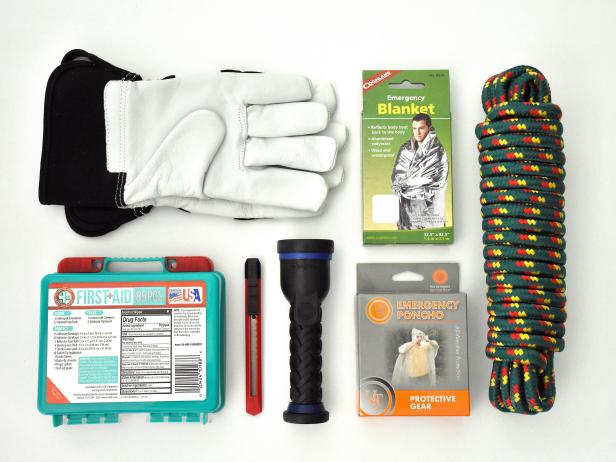
The Red Cross and the Center for Disease Control both offer great guides on general preparedness and recommend storing enough food, water and gear for three days per person in your household. If you’re starting from scratch and want to assemble your own kit, you can buy ready-made packs online, but those can be costly at around $100 for just food and water for one person. With a quick trip to your local big box store, you can knock out all the essential items and save a lot of money by assembling it yourself. We spent about $250 total for our kit that includes food, water, gear and aid for our family of two. We followed the Red Cross and CDC guides but added additional items. Here’s what is in our pack.
Water Essentials

Should a disaster strike, you don’t want to chance drinking tap water as water lines could become damaged or contaminated. Store plenty of clean, purified water for drinking, cooking and hygiene needs. You’ll need one gallon of water per person per day. And keep at least a three day supply per person. If you have to leave your home, it’s a good idea to pack water purifying tablets or on-the-go filter systems such as the LifeStraw. You can find these items in the camping section of a big box store or an outdoors and recreation store.
Food
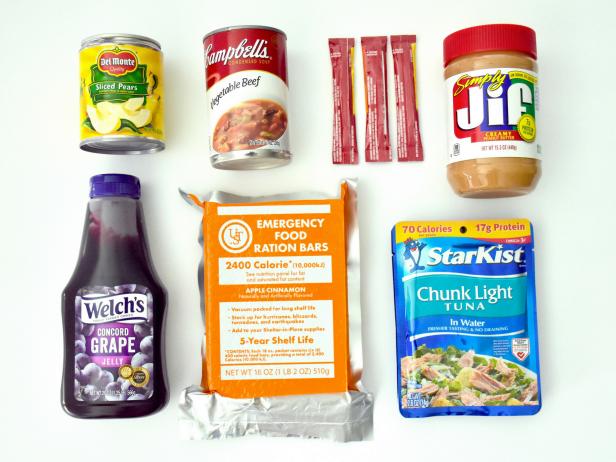
When assembling food for an emergency kit it’s important to shop for ready to eat and nonperishable foods as you may not be able to use your kitchen. Canned meats, fruits, soups and vegetables are great as they have a long shelf life. We also stocked up on packets of tuna. High-energy foods such as peanut butter, jelly, granola and trail mix are great choices, too. You can also buy military grade emergency ration bars at any outdoors store or the camping section of a big box store. We decided to add a 72-hour supply to our kit as the bars have the exact nutrition you need.
You can also toss in hard candy, gum or mints that are helpful if you have an upset stomach. And to be totally extra, I bought instant coffee packets because even in a zombie apocalypse, I need coffee.
First Aid and Medicine

A first aid kit is essential for any home but you should also include a duplicate kit for your emergency kit to ensure you have all the necessary supplies. At the very minimum, a first aid kit should include:
- safety pins
- soap
- bandages
- gloves
- sterile gauze pads
- baby wipes
- thermometer
- petroleum jelly
- hydrogen peroxide
- antibacterial ointment
- eye drops
It’s also a good idea to add non-prescription drugs such as antacids and IBuprofen. Talk to your doctor about any medications you take and what you would need if you couldn’t get to the pharmacy. Don’t forget special needs for anyone in your family and pack critical items such as diabetic insulin, hearing aids and backup batteries. If you wear glasses, pack backups, contacts and contact solution.
Home Essentials

If your home is damaged in a natural disaster, one of the first things you should do is turn off your gas, electric and water. Find out where your shut-off locations are and familiarize yourself with how to turn them off. It’s a good idea to have a wrench handy for this. Other essentials you need if the power goes out include:
- pliers
- camper stove
- paper cups
- paper plates
- plastic utensils
- battery-operated or hand-cranked radio
- flashlight
- extra batteries
- small fire extinguisher
- non-electric can opener
- utility knife
- tape
- matches in a waterproof container
- aluminum foil
- signal Flare
- pencil, pen and paper
- needles and thread or sewing kit
- general disinfectant spray
- household chlorine bleach
Gear
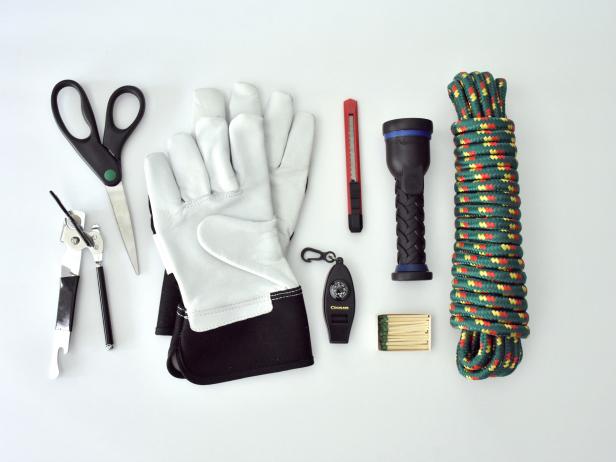
Not only is gear handy but some of these items could be lifesaving when navigating debris and shattered glass. Make sure you have one of the following for every member of your household:
- watch
- whistle
- respirator mask
- lightstick
- flashlight
- heavy-duty worker gloves
Solar powered or portable phone chargers are also a great idea. And we added nylon rope, an ax, small shovel, GPS, compass and jumper cables to our haul.
Hygiene
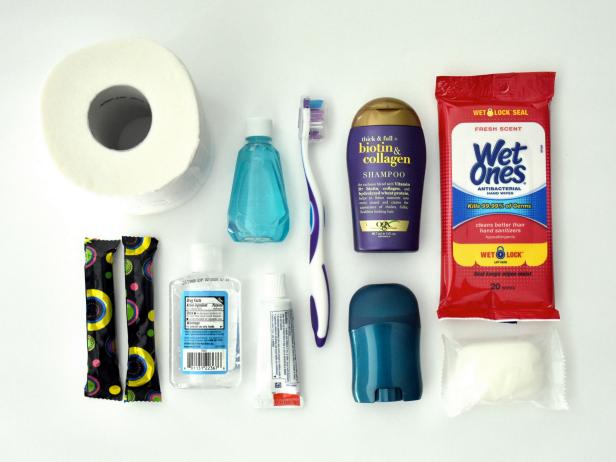
Make sure you stock up on enough toiletries such as toilet paper, feminine supplies, shampoo, toothpaste, mouthwash, toothbrushes, floss, soap and liquid detergent. You can find travel-sized options in most pharmacies and big box stores.
Clothing

If you have to leave your home, it’s important to wear and pack clothes that are appropriate for the outdoors. Dress in layers, pack extra warm socks and opt for moisture wicking fabric such as Merino wool. Outdoor brand SmartWool has a great line of base layers and socks that keep you warm and dry. For shoes, wear a pair of sturdy hiking boots. This will help protect your feet should you need to walk through debris or broken glass. Pack spare underwear and socks for everyone in the family and don’t forget warm hats and gloves. For outerwear, puffy down jackets are great because they keep you warm but also pack down and take up less space than other bulky coats and jackets.
Protection Against the Elements
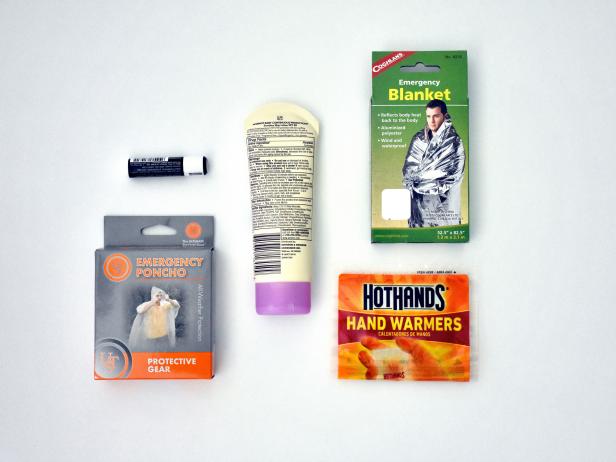
As you may need to leave your home, it’s important to think about what you’ll need outdoors. Pack plenty of sunscreen, sunglasses and hats for the family as well as rain gear such as ponchos, umbrellas and rain jackets. Pack warm blankets and toss in a couple of emergency thermal blankets, too. They don’t take up much space but can keep you warm if you’re stranded. You’ll find the little silver packets in most big box stores in the camping section or at any outdoors and recreation store. Hand and foot warmers such as HotHands are a great idea, too.
Documents and Data
If all your file cabinets were flooded and your computers destroyed, would you have a backup of your most important records? People don’t think about data but it’s just as important as first aid and gear. Your kit should include copies of important identification such as a driver’s license, birth certificate, social security card and passport. Also, include copies of important documents such as:
- a will
- insurance policies
- marriage certificates
- death certificates
- contracts and deeds
- stocks and bonds
- immunization records
Make a list of numbers and logins for important accounts such as your bank and credit cards should you need to prove you’re the account owner. And it’s always a good idea to have a list of important telephone numbers because without a working cell phone your contact list is useless.

This next recommendation might seem random but it’s a good idea to include an inventory of your valuable household goods including photos of expensive items. Why? Insurance companies use this information when filing claims and in the event, your home is severely damaged it will be difficult to think of all your possessions right at the moment. Having a record ensures you don’t forget something major. You can get an external hard drive to store information and photos of your belongings. This is also a great way to store important photographs such as wedding photography or photos of your kids.
Lastly, make sure you have extra copies of keys to your house, garage and vehicles. And include keys to a safety deposit box or safe in your home.
Pets

Don’t forget your pets! Like humans, pets should have a water and food supply for at least three days. If your pet has medications, include that in your first aid kit. And remember to include poop bags for dogs and cats.
Containers
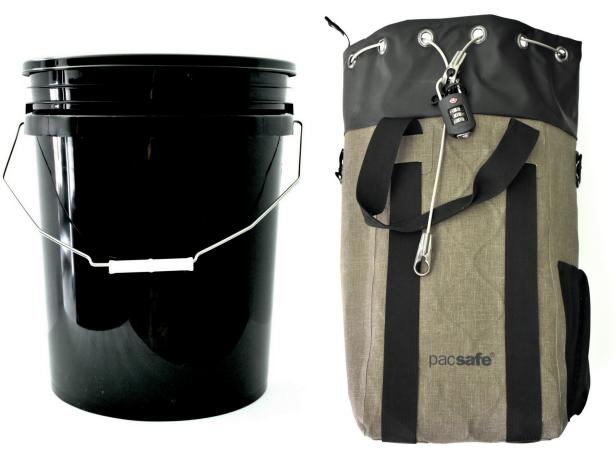
After stocking up on so much stuff, it’s important to make sure your gear stays clean and dry. You want at least two containers: a waterproof backpack and a large plastic bucket with an airtight lid. Why? Well, the backpack is so nothing gets wet and it’s easy to pick up and go should you need to leave your home quickly. We used the PacSafe Dry 15 Liter Anti-Theft Portable Safe because it folds down and fastens just like a giant kayak dry bag and it features a lock to keep belongings safe. But the bucket is for using the facilities. Because if your water is shut off, you’ll want a sanitary and contained option for your family.
Make sure you store these in an easy to reach place. There’s no time to dig through the back of a closet in an actual emergency.
Keep it Updated

Emergency kits need periodic maintenance. At least twice a year, check to make sure all food is still good, batteries haven’t corroded, all records and documents are up to date and that your pack is still in an easy to reach location. And if you’ve added a new member to your family, such as a baby or pet, make sure new items are added and that there is enough water for everyone in your household.

Comentarios
Publicar un comentario